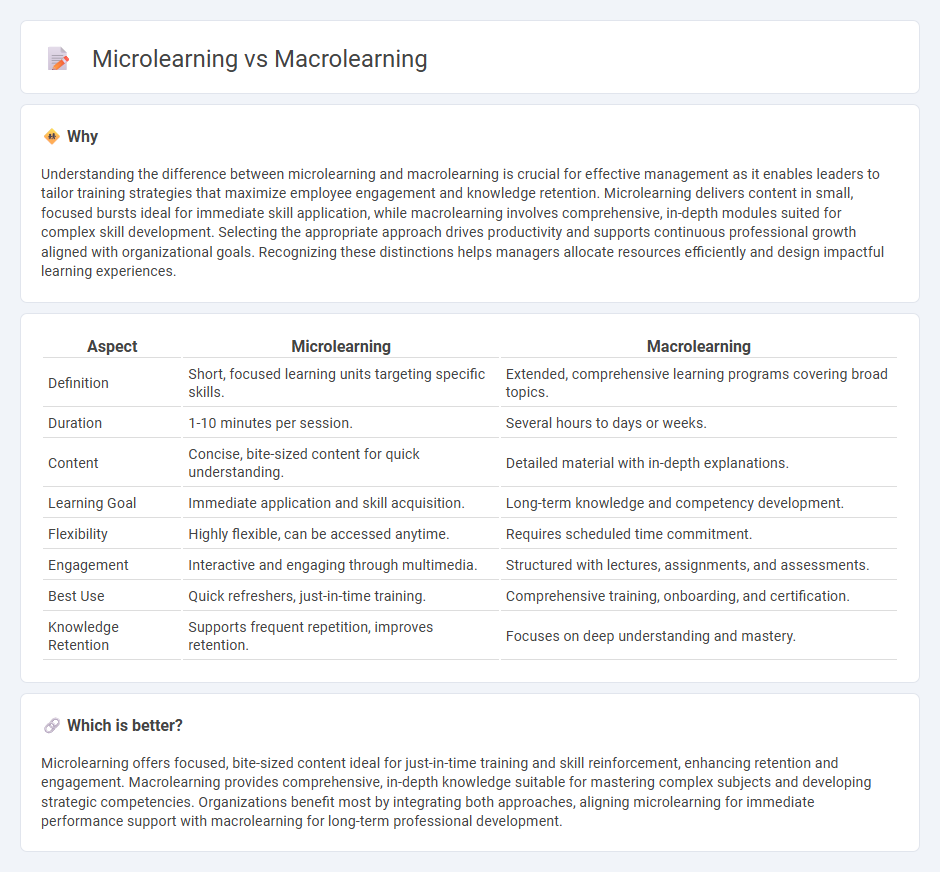
Microlearning delivers focused, bite-sized lessons optimized for quick skill acquisition and immediate application, enhancing learner engagement and retention. Macrolearning provides comprehensive, in-depth understanding through extended content, suitable for complex topics requiring thorough exploration and integration. Explore these learning approaches to determine the best strategy for your organization's training needs.
Why it is important
Understanding the difference between microlearning and macrolearning is crucial for effective management as it enables leaders to tailor training strategies that maximize employee engagement and knowledge retention. Microlearning delivers content in small, focused bursts ideal for immediate skill application, while macrolearning involves comprehensive, in-depth modules suited for complex skill development. Selecting the appropriate approach drives productivity and supports continuous professional growth aligned with organizational goals. Recognizing these distinctions helps managers allocate resources efficiently and design impactful learning experiences.
Comparison Table
| Aspect | Microlearning | Macrolearning |
|---|---|---|
| Definition | Short, focused learning units targeting specific skills. | Extended, comprehensive learning programs covering broad topics. |
| Duration | 1-10 minutes per session. | Several hours to days or weeks. |
| Content | Concise, bite-sized content for quick understanding. | Detailed material with in-depth explanations. |
| Learning Goal | Immediate application and skill acquisition. | Long-term knowledge and competency development. |
| Flexibility | Highly flexible, can be accessed anytime. | Requires scheduled time commitment. |
| Engagement | Interactive and engaging through multimedia. | Structured with lectures, assignments, and assessments. |
| Best Use | Quick refreshers, just-in-time training. | Comprehensive training, onboarding, and certification. |
| Knowledge Retention | Supports frequent repetition, improves retention. | Focuses on deep understanding and mastery. |
Which is better?
Microlearning offers focused, bite-sized content ideal for just-in-time training and skill reinforcement, enhancing retention and engagement. Macrolearning provides comprehensive, in-depth knowledge suitable for mastering complex subjects and developing strategic competencies. Organizations benefit most by integrating both approaches, aligning microlearning for immediate performance support with macrolearning for long-term professional development.
Connection
Microlearning and macrolearning are interconnected by their complementary roles in effective management training strategies; microlearning delivers focused, short-duration lessons that enhance specific skills, while macrolearning provides comprehensive, in-depth knowledge necessary for long-term managerial development. Integrating microlearning modules within broader macrolearning frameworks optimizes knowledge retention and application by addressing both immediate learning needs and strategic competencies. This synergy supports continuous professional growth and adaptability in dynamic management environments.
Key Terms
Scope
Macrolearning involves comprehensive, in-depth educational experiences covering broad topics over extended periods, ideal for mastering complex subjects or skills. Microlearning delivers content in small, focused bursts, targeting specific knowledge or skills for quick understanding and immediate application. Explore further to discover which approach best fits your learning goals and contexts.
Duration
Macrolearning typically spans several hours to days, allowing for deep, comprehensive understanding of complex topics, while microlearning delivers content in short, focused segments lasting a few minutes, ideal for quick skill acquisition and knowledge reinforcement. The extended duration of macrolearning supports thorough exploration and synthesis, contrasting with microlearning's bite-sized approach designed for just-in-time application and better retention through repetition. Explore more about how these differing durations impact learning outcomes and which approach suits your training needs best.
Learning Objectives
Macrolearning targets comprehensive learning objectives by covering broad subjects in extended sessions, ideal for deep understanding and skill mastery. Microlearning breaks down complex goals into small, focused lessons that facilitate quick knowledge retention and practical application. Discover how to optimize your training strategy by exploring the strengths of both macrolearning and microlearning methods.
Source and External Links
Microlearning vs. Macrolearning: Choosing the Right Learning ... - Macrolearning involves longer, in-depth learning sessions lasting from hours to months, offers structured and comprehensive mastery through formats like formal classes, online courses, bootcamps, and certification programs, providing a deep understanding and recognized qualifications.
Microlearning, Macrolearning. What Does Research Tell Us? - Macrolearning focuses on larger skill areas with knowledge, practice, and feedback over time, promoting better retention and application compared to concentrated learning events.
Micro and Macro Learning: Striking the Right Balance - DDI - Macrolearning supports deep skill growth through structured, longer sessions that are essential for mastering complex skills, though it requires significant time commitment and well-designed follow-up for retention.
 dowidth.com
dowidth.com